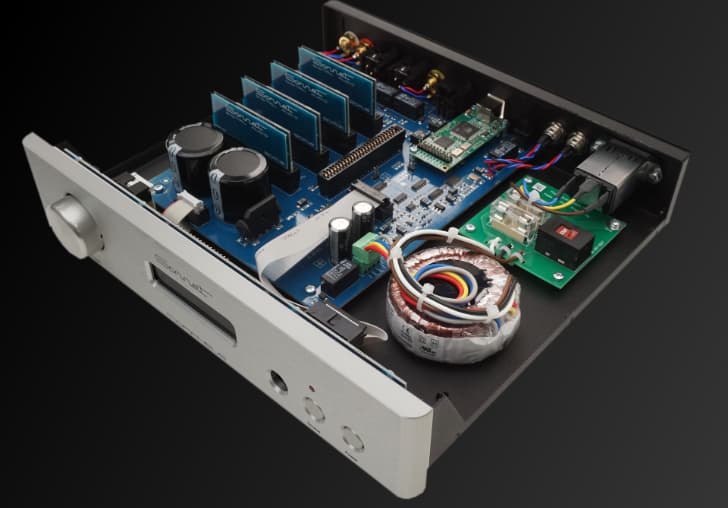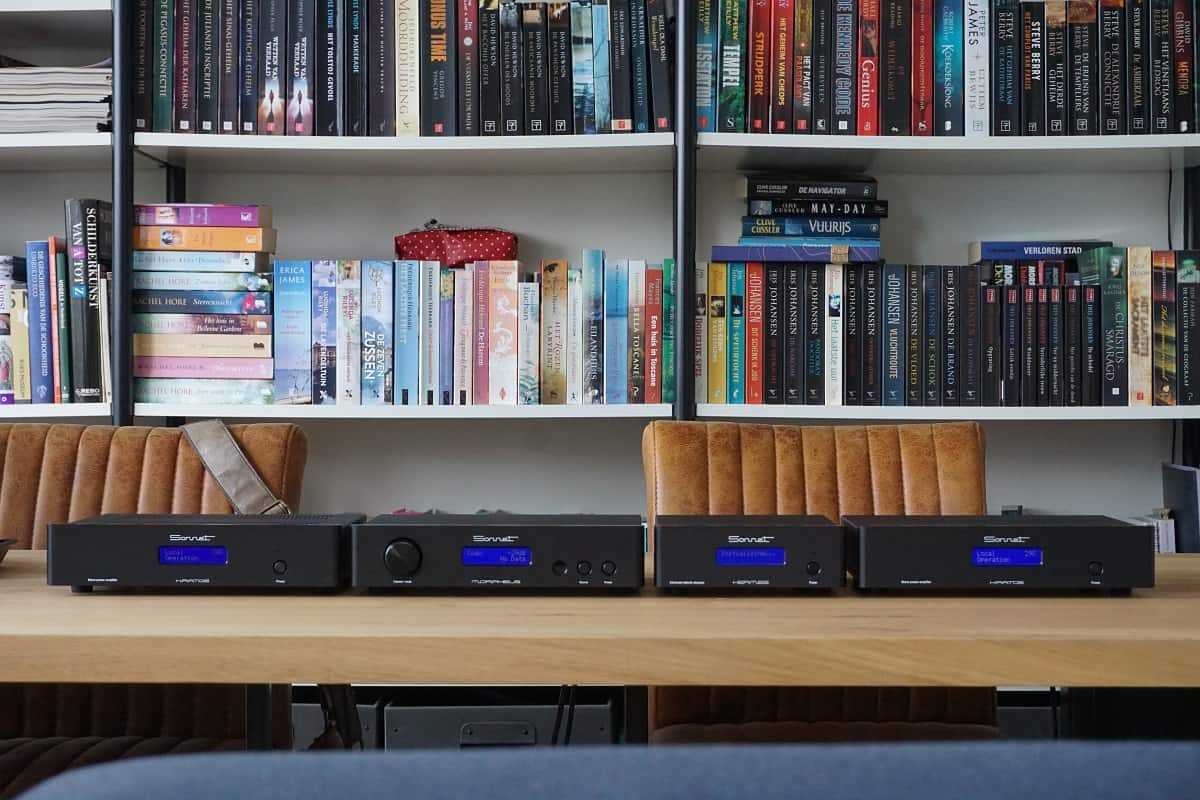Metrum Newsletter - May 2024

Birth pictures of Sonnet Morpheus, including annotations

Metrum Newsletter
Welcome to our newsletter.
It's a 5 minute read, gives a hint at what's been happening and gives an idea of the Musical future.
Newsletter
May already! Time flies when you're building DACs and other beautiful audio equipment. Jewel Akens' birds and bees are flying everywhere. "Girls just want to have fun" with "The boys of summer", so it's time for an anatomy lesson... oh, the parts are showing.. don't worry R2... This is R2R, and perfectly SFW! May is also the month of High End show in Munich, Germany. We will not be there as exhibitor this year, although Roelof will go to Munich to meet our dealers and distributors. We also have a special action for our customers. Contact us if you're interested in the Morpheus DAC for extras. This action is valid until June 7, 2024. We have a little more technical newsletter this time, but with coupling to tangible and real-world examples. We hope you appreciate it and the special Morpheus action we have for you...
Physical
The Sonnet Morpheus DAC is 29 cm wide, 25 cm deep and 7 cm high (including the feet). In a 44 cm dominated world, it is an odd-ball, and yes, it was designed to be different. Sonnet is our value-for-money, no-nonsense audio brand where most of the cost is reflected in the circuitry. The Morpheus is well-received in numerous reviews, and with this newsletter, we are going to look under the hood and discuss what is in there. We will elaborate a little more on the technology too.

Sonnet Morpheus MKI – first production run
Features
The Morpheus is a feature-packed DAC that can be used as a digital pre-amplifier that directly outputs to power amplifiers, but also as a DAC in a chain with a conventional pre- or integrated amplifier. As with all Metrum and Sonnet DACs, the Morpheus is Non OverSampling (NOS) and digital-filter-less. This implies that the DAC is bit-perfect from beginning to end. All the Musical bits that come in through the inputs arrive directly at the DAC modules. There's only input signal selection (no change of bits) and an optional MQA module (original studio quality when fed with MQA content) in between. The MQA module is completely bypassed when it is not in use. Even though the Morpheus employs a form of digital volume control, the incoming bits aren't changed by the volume control either. So, sound quality does NOT degrade due to controlling the volume, since the volume control is completely out of the signal path. In fact, when the volume control is at 0dB (fully clockwise), the reference voltage is at its maximum value, output is maximum, and the Morpheus behaves exactly like a DAC without volume control. As extra, the volume can be set to Fixed in the menu, which means that when the Morpheus is started up, the volume is (and stays) at that exact position. We explained our unique volume control implementation in our October 2023 newsletter. In off-the-shelf audio DAC chips, this type of volume control is not available. The Sonnet Morpheus has a unique design, which is reflected on several fronts. Most of all it is a NOS DAC: No Ordinary Stuff. We designed the Morpheus from top to bottom, so we know exactly what's in there. Let's take a deeper dive into the matter.

Click to download a high-res version with tons of detail. Artwork made by Austrian high-end audio (and Metrum) enthusiast Paul Grill. More about how our paths crossed in the closing words.
Infographic explanation
The beautifully made infographic shows the Morpeus DAC with all the connections, buttons and components that make it work the way it does. Below is a more detailed explanation of all the parts. We go from the upper left corner to the lower left corner first.
Muting
Muting relais are used instead of transistors or FETs. When a muting transistor or FET is used, the non-linearities of the transistor can influence the sound when muting is off. By using relays, which is a form of electromechanical switch, no distortion or leakage is present in the non-muting state (i.e. playing sound) of the component. It takes up more board space and it is less economical to implement relays, but is sound-wise very justifiable.
DAC modules
The 4 DAC modules (2 per channel) of the Morpheus are proprietary and designed and made in-house. This is the heart of our NOS DAC technology. Since the phase difference is less than 10 degrees over the audible frequency range, the lows and highs are in phase, keeping the timing and impulse behavior accurate. This is reflected in the wide and deep sound stage. Due to the NOS principle, the output signal is also free of unnatural sounding pre- and post-ringing. A true-to-nature sound is what follows. By stacking 2 DAC chips on top of each other, the noise floor is at a staggering -155dB. A technique called forward correction, and unique to our DAC technology. Where NOS DAC technology usually doesn’t measure particularly well, our Morpheus has a THD of 0.004% and has a linearity down to at least -135dB. Due to the large linear range, the effective number of bits (ENOB) that are converted without 'drowning' in noise is at the 22-bit level. This makes the Morpheus very suitable for studio work as well!
Input module
A USB or I2S input module can be placed in the upgrade slot of the Morpheus DAC. The USB module couples to your computer and helps to transport USB to I2S and turn those ones and zeros to Music. The I2S module can be used with one of our streamers (Ambre or Hermes), or with third-party hardware. With your order, you can choose to have the I2S module fitted instead of the USB module.
MQA module
The optional MQA module has its own slot and is used for decoding MQA-encoded content. MQA stands for Master Quality Authenticated and enables studio quality playback at home for MQA encoded tracks. MQA was recently purchased by Lenbrook (NAD, Bluesound), ensuring its future.
Smooth power supply
Oversized capacitors are used to filter out nasty spikes and buffer the incoming voltage. The rectifier and snubber filters are also drawn. Together with other specialized circuitry, diode switching noise is suppressed to a minimum, helping to achieve that vanishingly low noise floor. This translates to darker backgrounds in recordings, which is an absolute must to achieve a high-resolution system.
Remote switching
Remote outputs switch other equipment on via relays. A set of 2 was implemented so monoblock amplifiers can also be turned on with the press of a single button.
Low noise circuit board
4-layer circuit boards are more expensive than 2-layer boards but are also less noisy if routed correctly. Return paths for current can be kept small, resulting in a low-noise layout. Proper design techniques help with noise immunity and minimizing radiated and conducted radio interference.
Toroidal transformer
A 15 watt (actually VA instead of watt) dual voltage toroidal transformer is used, of which only 8 watts are used. That delivers plenty of juice to help Morpheus power the audio ‚Matrix‘. Furthermore, oversized transformers tend to have better power regulation and a lower impedance, which helps with current driving capabilities and better impulse behavior.
Input power filtering
A line filter is implemented to filter out interference, so noise doesn't interfere with your Music. It also makes this DAC practically immune to disturbances regularly found in the outside world.
Programming socket
Programming socket for the front panel. Only used in production. We (nor customers) can't alter or improve the sound of the DAC by fiddling with it. Now you know what it's for.
Volume control
The connector next to it is dedicated to volume control. It divides the regulated reference voltage and sends it back to the main circuit board, which in effect regulates volume. We already touched upon this unique feature, and you can find more info about how it works in our October 2023 newsletter.
Logic connector
Finally, the logic connector does the digital input selection from the ‚far‘ side of the DAC, sends muting signals and helps display the status of the DAC. Near the logic connector is also the IR receiver. With the six-button remote you can control On/Off, Source up/down, Muting and Volume up/down.

Morpheus Remote Control - the housing is milled from a solid block of aluminium
S/PDIF receiver
Back to the top; the SP/DIF receiver decodes signals on the Toslink, Coax and AES/EBU inputs and converts them to an internal I2S signal. This is the signal our DAC modules need to convert to Analog. More info on why SPDIF and I2S are 'in the mix' can be found in our January 2024 newsletter.
Reference voltage buffering
Buffering of the reference voltage is applied to make it as stable and noise-free as possible. The volume is set and stays at the correct state, it would not go up and down with slow changes. Filtering out noise is practically the same thing, as noise is a series of fast and unwanted changes. Stable and slow is key, so the corner frequency of the filtering is also very low.
Power and housekeeping
The last three buttons all show power-related functions. Separate analog regulators are used to rock separately from the digital (or housekeeping) regulators. This lowers output impedance and helps to suppress crosstalk and noise. You can imagine that fast-changing digital signals can induce noise spikes or even unwanted tones. These should not interfere with the carefully reconstructed analog signals. Therefore, almost half of Morpheus' internal circuitry is power or power regulation.
At the bottom of the infographic the specifications are listed, we added them for the number freaks. Back to the top row!
Outputs
The balanced XLR outputs and single-ended Cinch outputs can be used simultaneously: the XLR output, when used with a fully balanced connection, has an even lower noise floor, giving room for more micro-details to be heard. An advantage of having Cinch as well as XLR outputs is that you can always connect an extra subwoofer. With the integrated volume control, you can also always change or upgrade to separate monoblock amplifiers (if you don't already have monoblocks). A separate pre-amp is not needed. Volume control works for both the XLR and Cinch outputs at the same time, so connecting a subwoofer to the single-ended outputs is very easy.
Fun facts
- The Morpheus (and its other siblings) is hand-built in our factory in Den Bosch, the Netherlands.
- Morpheus is currently in the MKII phase. The MKI doesn't have the hardware -10dB attenuator yet. For the rest, functionality is the same.
- Morpheus is available in Black and Silver. Eastern markets seem to prefer Silver, whereas Westerners usually prefer Black.
- Morpheus has won several prizes in the audio press. Links to reviews can be found on the Morpheus product page.
- One of Europe's largest vinyl pressers uses Sonnet Morpheus DACs to drive their cutting lathes when a recording is delivered in a digital format. So yes, we also love vinyl!
- The remote control is milled from a solid block of aluminum. The luxurious finish is made by tumbling and hard anodizing. To the touch, this also gives it a nice texture. The buttons are solid aluminum and have the same surface finish.
- Shameless plug: the Sonnet Pasithea exhibits even better specifications and more functionality. She has more DAC modules, a lower noise floor, lower output impedance and an even more spacious sound. We just had to tell you!

A Morpheus 'in the wild' – it also blends well with a nice interior design
Closing words
About Paul Grill... Paul was so grateful we solved a problem in his Metrum Amethyst that he wanted to illustrate for us. Then, things got even more interesting, since Paul (and friends) are starting an online audio magazine called SONORIAN. An interview with our engineer Roelof followed and will be up for publication shortly. There, you can read more about the history of Metrum and Sonnet, and get a feel for the craftsmanship and level of detail we feel our customers deserve.
A topic we get questions on regularly is leaving equipment on (or not). Some customers notice a difference in sound if they leave their equipment on for a prolonged period. Our answer is always the same: Yes, the power bill is higher if you leave equipment on. The Morpheus was designed to be able to operate continuously; 24/7, 365 days of the year. The lifespan of the Morpheus is not significantly impacted by leaving it on. We have equipment in the field that is more than 10 years old. When opened, it looks like it was put together yesterday. We love quality!
A final topic we would like to touch upon is our dealers. We work with our dealer network so you, our customers, can visit, listen and compare audio equipment. For customers where there is no dealer in the direct area - or customers that simply know what they want - we offer direct sales while handling a 30-day money-back policy. This means you can always order and listen in your setup. Back to dealers, because they support you, the customer, and us in sales and after-sales care.
Orchestral Audio is one of our dealers and they recently upgraded from a cozy high-end studio to a very spacious and luxurious audio store. At Orchestral Audio you'll find John and Marc, two high-end audio enthusiasts with a lot of audio know-how, while they don't forget the inner man. The Metrum and Sonnet brands are directly available for listening through Acelec Model One speakers. Several listening areas are available for your listening pleasure. You can now visit Orchestral Audio in Wijchen at Sterrebosweg 11, 6602AT. Gentlemen, congratulations on your new and wonderful store!
Keep listening to beautiful Music, we'll talk soon...

Team Metrum Acoustics
You are receiving this newsletter because you previously signed up for our newsletter, if this is an outdated preference click below to unsubscribe.








